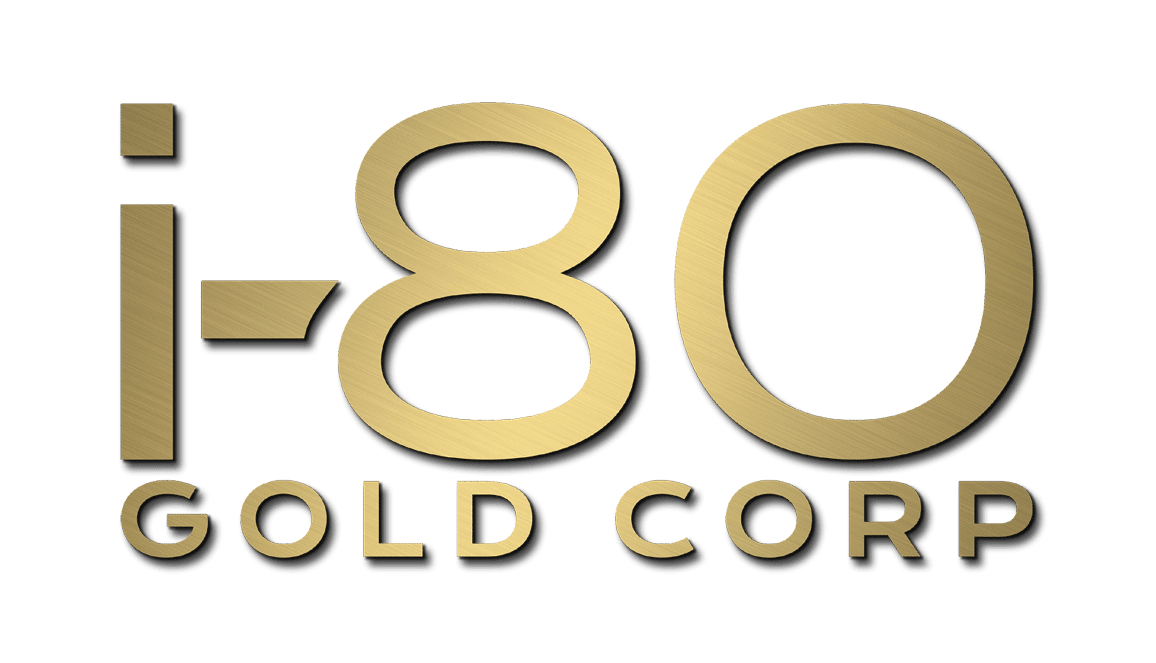i-80 Gold Reports Q2 2022 Operating Results
Reno, Nevada, August 9, 2022 – i-80 GOLD CORP. (TSX:IAU) (NYSE:IAUX) (“i-80”, or the “Company”) is pleased to report its operating and financial results for the three and six months ended June 30, 2022. i-80’s Consolidated Financial Statements (“financial statements”), as well as i-80’s Management’s Discussion and Analysis of Operations and Financial Condition (“MD&A”) for the three and six months ended June 30, 2022, are available on the Company’s website at www.i80gold.com, on SEDAR at www.sedar.com, and on EDGAR at www.sec.gov.
Unless otherwise stated, all amounts referred to herein are in U.S. dollars.
2022 Second Quarter Highlights:
-
- Commenced trading on the New York Stock Exchange on May 19, 2022 under the symbol IAUX
- Q2 2022 gold sales of $3,507 ounces at an all-in sustaining cost of $1,356 per ounce sold1
- Funds received for the previously-announced gold prepay and silver purchase and sale agreements totaling $75 million
- June 30 cash balance of $101 million in addition to $31 million in restricted cash
- Drilling at Granite Creek continued with multiple high-grade intercepts in the Ogee and South Pacific zones (23,944 core feet and 8,157 reverse circulation (RC) feet drilled)
- Increased the size of the Granite Creek property package by approximately 1,280 acres (518Ha), extending exposure along the primary fault structure by approximately 1.6 km north towards the Turquoise Ridge Mine, and 1.6 km south of Granite Creek
- Continued step-out and infill drilling at Ruby Hill with multiple high-grade intercepts (21,595 core feet and 25,150 RC feet drilled)
- Engineering study of Lone Tree autoclave refurbishment continued on plan
- Entered into agreement to acquire key water rights for the development of the Cove Project
2022 Year to date Highlights:
-
- Gold sales of 4,996 ounces; all-in sustaining cost of $1,326 per ounce sold1
- Commenced development of exploration decline at McCoy-Cove (approximately 1,300 feet of advance now completed); drilling expected to commence in Q4
- Completed first gold sale in Company history
- Shipment of sulfide ore from Granite Creek for processing started in June
- A total of 145,887 feet (core and RC) drilled by the end of the second quarter
“The Company continues to aggressively pursue our peer-best production growth strategy.”, stated Ryan Snow, Chief Financial Officer of i-80. “Several key development milestones have been achieved in the first half of the year along with continued exploration success, demonstrating the potential to extend known mineralization. In addition, the gold prepay and silver purchase and sale agreements funded during the quarter and gold sales continued from the residual leaching at Ruby Hill and Lone Tree resulting in a cash balance of $101 million dollars.”
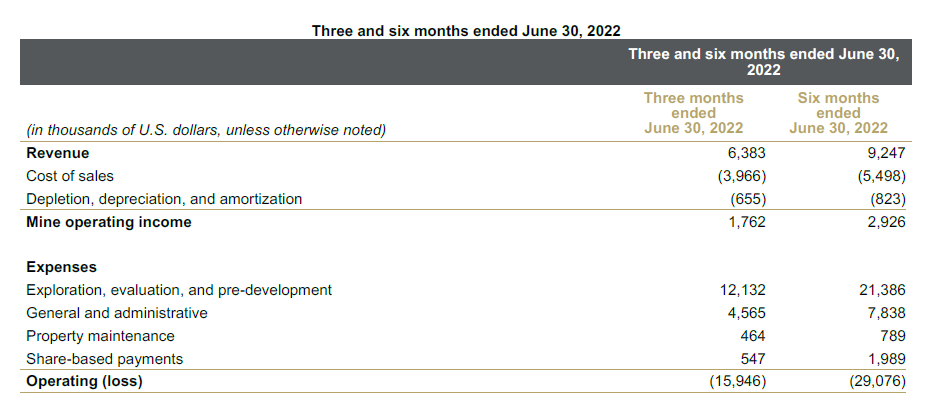
Production and sales from residual leaching at Ruby Hill and Lone Tree totaled 3,507 ounces for the quarter and 4,996 ounces year to date at cash costs per ounce sold of $1,122 and $1,093, respectively, and all-in sustaining cost per ounce sold of $1,356 and $1,326, respectively.
Exploration, evaluation, and pre-development costs were $12.1 million in Q2 and $21.4 million year to date (YTD). This spend reflects mainly the exploration and pre-development work at Granite Creek and Ruby Hill.
Lone Tree Processing Facilities
Lone Tree is expected to become the hub of i-80’s Nevada operations and the central processing facility for mineralization from the first four planned mining projects. Importantly, Lone Tree is host to infrastructure that, following successful refurbishment efforts, will position i-80 as one of only three companies in the United States capable of processing both oxide and refractory mineralization.
During the quarter, the Company advanced a detailed engineering study for the restart of the autoclave. The study is progressing on plan and is expected to be completed in the second half of 2022. The Company also continued permitting for the development of the Buffalo Mountain open pit where gold mineralization is expected to be processed at the Lone Tree leach pad facility.
Residual leaching activities at Lone Tree produced 942 ounces gold during Q2 and 1,785 YTD at a cash cost per ounce sold of $9261 and $8791, respectively, and all-in sustaining cost per ounce sold of $1,5601 and $1,3431, respectively.
Granite Creek
In the second quarter, 2022, drilling continued for resource expansion on the Ogee and South Pacific Zones with multiple high-grade intercepts. Completed 23,944 feet of core drilling and 8,157 feet of RC drilling. The amount of drilling completed as of June 30, 2022 totaling 71,952 feet was in line with the Company’s drilling plan. Drilling targets were expansion and delineation of the newly discovered South Pacific Zone as well as delineation drilling that targeted the Otto, Adam Peak, and Ogee fault zones with underground drilling.
McCoy-Cove
Construction of the exploration decline continued on plan and has been advanced approximately 1,300 feet. Additional work on metallurgical and hydrology studies, engineering of de-watering and mining options, and reclamation activities associated with the inactive tailings storage facility is also being advanced.
Ruby Hill
A major, multi-drill, exploration campaign is underway that will see a minimum of 20,000 metres drilled in 2022 followed by a resource update. Multiple gold and polymetallic deposits and exploration targets exist on the property with mineralization open along strike and at depth.
The Company has commenced permitting for the construction of a decline to access the high-grade Ruby Deeps deposit and the Blackjack Zone with the intent of trucking refractory mineralization for processing at Lone Tree.
In the second quarter, infill and step-out drilling of the Ruby Deeps zone continued with multiple high-grade intercepts and multiple brownfield exploration targets were tested. 21,595 feet of core drilling and 25,150 feet of RC drilling was completed during the quarter, with a combined total of 73,935 feet completed in the first half, in line with the Company’s drilling plan. Owing to the substantial success of the 2022 exploration campaign at Ruby Hill, the program has been expanded.
Residual leaching activities at Ruby Hill produced 2,565 ounces gold during Q2 and 3,211 YTD at a cash cost per ounce sold of $1,1941 and $1,2111, respectively, and all-in sustaining cost per ounce sold of $1,2821 and $1,3161, respectively.
| Conference Call Participant Details | |
| Webcast URL: | https://app.webinar.net/gLQAq5YqOR5 |
| Confirmation #: | 3332379 |
| Phone Number Information: | CLICK HERE! |
Qualified Person
The scientific and technical information contained in this press release was reviewed by Tim George, PE, Mining Operations Manager, and a Qualified Person within the meaning of National Instrument 43-101.
About i-80 Gold Corp.
i-80 Gold Corp. is a well-financed, Nevada-focused, mining company with a goal of achieving mid-tier gold producer status through the development of multiple deposits within the Company’s advanced-stage property portfolio anticipated to be processed at the centrally located Lone Tree processing facility and autoclave.
For further information, please contact:
Ewan Downie – CEO
Ryan Snow – CFO
Matthew Gollat – EVP Business & Corporate Development
1.866.525.6450
Info@i80gold.com
www.i80gold.com
Forward-looking information
Certain statements in this release constitute “forward-looking statements” or “forward-looking information” within the meaning of applicable securities laws, including but not limited to, actual production results and costs, results of operation outcomes and timing of updated technical studies at the Company’s mineral projects, timing to advance mineral projects to production and advance permitting and feasibility work on the on its mineral projects and future production, development and exploration results. Such statements and information involve known and unknown risks, uncertainties and other factors that may cause the actual results, performance or achievements of the company, its projects, or industry results, to be materially different from any future results, performance or achievements expressed or implied by such forward-looking statements or information. Such statements can be identified by the use of words such as “may”, “would”, “could”, “will”, “intend”, “expect”, “believe”, “plan”, “anticipate”, “estimate”, “scheduled”, “forecast”, “predict” and other similar terminology, or state that certain actions, events or results “may”, “could”, “would”, “might” or “will” be taken, occur or be achieved. These statements reflect the Company’s current expectations regarding future events, performance and results and speak only as of the date of this release.
Forward-looking statements and information involve significant risks and uncertainties, should not be read as guarantees of future performance or results and will not necessarily be accurate indicators of whether or not such results will be achieved. A number of factors could cause actual results to differ materially from the results discussed in the forward-looking statements or information, including, but not limited to: material adverse changes, unexpected changes in laws, rules or regulations, or their enforcement by applicable authorities; the failure of parties to contracts with the company to perform as agreed; social or labour unrest; changes in commodity prices; and the failure of exploration programs or studies to deliver anticipated results or results that would justify and support continued exploration, studies, development or operations. For a more detailed discussion of such risks and other factors that could cause actual results to differ materially from those expressed or implied by such forward-looking statements, refer to i-80’s filings with Canadian securities regulators, including the most recent Annual Information Form, available on SEDAR at www.sedar.com.
NON-IFRS FINANCIAL PERFORMANCE MEASURES
The Company has included certain terms or performance measures commonly used in the mining industry that are not defined under IFRS in this document. These include: by-product cash cost per ounce sold, by-product all-in sustaining cost (“AISC”) per ounce sold, earnings before interest, tax, depreciation and amortization, capital expenditures (expansionary), capital expenditures (sustaining), adjusted net earnings and average realized price per ounce. Non-IFRS financial performance measures do not have any standardized meaning prescribed under IFRS, and therefore, they may not be comparable to similar measures employed by other companies. The data presented is intended to provide additional information and should not be considered in isolation or as a substitute for measures prepared in accordance with IFRS and should be read in conjunction with the Company’s Financial Statements.
Definitions
Adjusted earnings and earnings per share excludes significant write-down adjustments.
All-in sustaining costs on a by-product basis per ounce include total production cash costs on a by-product basis plus incorporates costs related to sustaining production.
Average realized gold price represents the sales price of gold per ounce before deducting mining royalties, treatment and refining charges as well as gain or losses derived from the offtake agreement with Orion.
By-product credits include revenues from the sale of by-products from operating mines.
Capital expenditure (expansionary) is a capital expenditure intended to expand the business or operations by increasing production capacity beyond current levels of performance and includes capitalized exploration.
Capital expenditure (sustaining) is a capital expenditure necessary to maintain existing levels of production. The sustaining capital expenditures maintain the existing mine fleet, mill and other facilities so that they function at levels consistent from year to year.
Cost of sales per ounce sold is calculated by dividing the attributable cost of sales by the attributable ounces sold.
Exploration and evaluation (sustaining) expense is presented as mine site sustaining if it supports current mine operations.
Rehabilitation – accretion and amortization include depreciation on the assets related to the rehabilitation provision of gold operations and accretion on the rehabilitation provision of gold operations.
Average realized gold price per ounce of gold sold
Average realized gold price per ounce of gold sold is a non-IFRS measure and does not constitute a measure recognized by IFRS and does not have a standardized meaning defined by IFRS. It may not be comparable to information in other gold producers’ reports and filings.
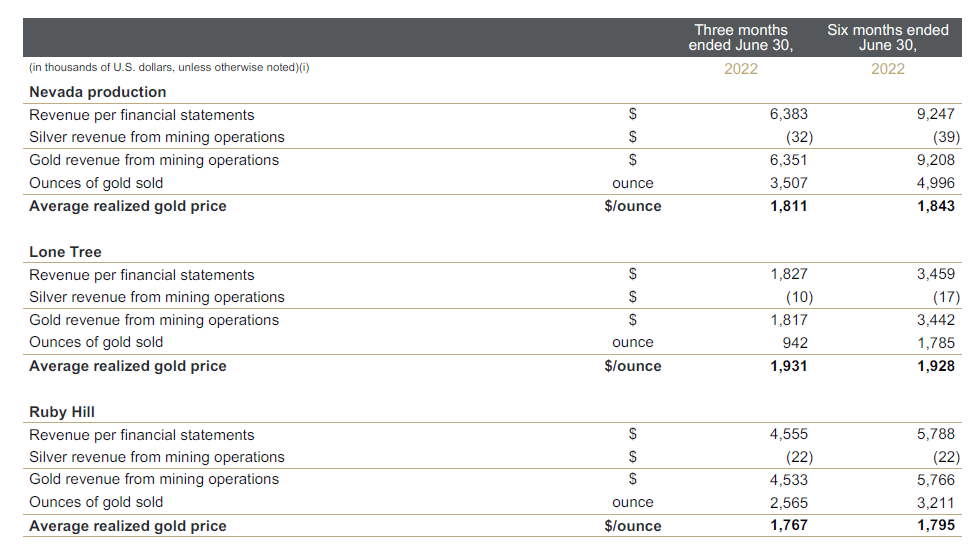
Cash Costs
Cash costs per ounce sold represents all direct and indirect operating costs related to the physical activities of producing gold, including on-site mining costs, processing, third-party smelting, refining and transport costs, on-site general and administrative costs, community site relations, royalties and royalty tax. State of Nevada net proceeds taxes are excluded. Cash costs incorporate the Company’s share of production costs but exclude, among other items, the impact of depletion, depreciation and amortization (“DD&A”), reclamation costs, financing costs, capital development and exploration and income taxes. In order to arrive at consolidated cash costs, the Company includes its attributable share of total cash costs from operations where less than 100% interest in the economic share of production is held.
Cash cost: by-product – When deriving the cash costs associated with an ounce of gold, the Company includes by-product credits, as the Company considers that the cost to produce the gold is reduced as a result of the by-product sales incidental to the gold production process. Accordingly, total production costs are reduced for revenues earned from silver sales.
Cash costs per ounce is a common financial performance measure in the mining industry, but the term does not have any standardized meaning. In determining its cash cost and cash cost per ounce, the Company has considered the guidelines provided by the World Gold Council, a non-regulatory, non-profit market development organization for the gold industry. A Company’s adoption of the standard is voluntary and other companies may quantify these measures differently as a result of different underlying principles and policies applied.
All-in Sustaining Costs (“AISC”)
AISC include total production cash costs incurred at the Company’s mining operations, which forms the basis of the Company’s by-product cash costs. Additionally, the Company includes sustaining capital expenditures which are expended to maintain existing levels of production (to which costs do not contribute to a material increase in annual gold ounce production over the next 12 months), rehabilitation accretion and amortization, general and administrative (excluding stock compensation) and exploration and evaluation expenses. The measure seeks to reflect the full cost of production from current operations, therefore expansionary capital is excluded. Certain other cash expenditures, including tax payments (including the State of Nevada net proceeds tax), dividends and financing costs are also excluded. The Company reports AISC on a per ounce sold basis.
This financial performance measure was adopted as a result of an initiative undertaken within the gold mining industry; however, this performance measure has no standardized meaning and should not be considered in isolation or as a substitute for measures of performance prepared in accordance with IFRS. In determining AISC, the Company has considered the guidelines provided by the World Gold Council, a non-regulatory, non-profit market development organization for the gold industry. A Company’s adoption of the standard is voluntary and other companies may quantify these measures differently as a result of different underlying principles and policies applied.
The following table provides a reconciliation on a by-product basis for gold cash cost and AISC for the three and six months ended June 30, 2022:
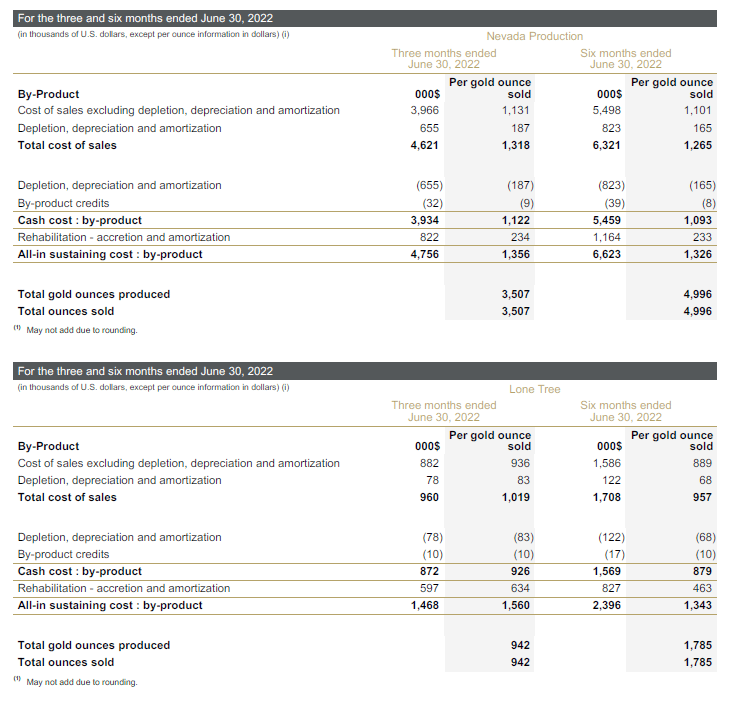
Adjusted Earnings
Adjusted earnings and basic adjusted earnings per share are non-IFRS measures that the Company considers to better reflect normalized earnings because it eliminates non-recurring items. Certain items that become applicable in a period may be adjusted for, with the Company retroactively presenting comparable periods with an adjustment for such items and conversely, items no longer applicable may be removed from the calculation. Neither adjusted earnings nor basic adjusted earnings per share have any standardized meaning prescribed by IFRS and are therefore unlikely to be comparable to similar measures presented by other companies.
The following table shows a reconciliation of adjusted earnings for the three and six months ended June 30, 2022 and 2021, to the net earnings for each period.
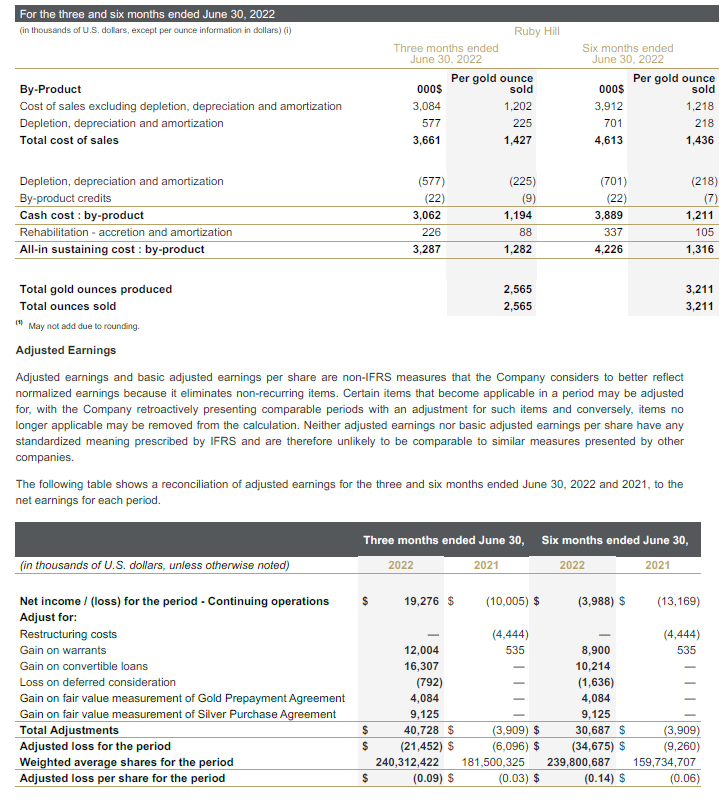
1 Specified financial measure which is not a standardized measure under IFRS and may not be comparable to similar specified financial measures used by other entities. Please see “Non-IFRS Financial Performance Measures” for the composition of such specified financial measure, an explanation of how such specified financial measure provides useful information to a reader and the purposes for which management of i-80 uses the specified financial measure, and where required, a reconciliation of the specified financial measure to the most directly comparable IFRS measure.
